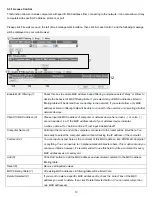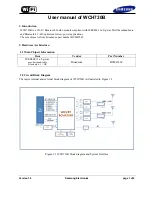
f. If you just can’t connect to one or more website, but you can still use other internet
services, please check URL/Keyword filter.
g. Try to reset the router and try again later.
h. Reset the device provided by your Internet service provider too.
i. Try to use IP address instead of hostname. If you can use IP address to communicate
with a remote server, but can’t use hostname, please check DNS setting.
I can’t locate my router by my
wireless client
a. ‘Broadcast ESSID’ set to off?
b. All two antennas are properly secured.
c. Are you too far from your router? Try to get closer.
d. Please remember that you have to input ESSID on your wireless client manually, if ESSID
broadcast is disabled.
File download is very slow or
breaks frequently
a. Are you using QoS function? Try to disable it and try again.
b. Internet is slow sometimes, being patient.
c. Try to reset the router and see if it’s better after that.
d. Try to know what computers do on your local network. If someone’s transferring big files,
other people will think Internet is really slow.
e. If this never happens before, call you Internet service provider to know if there is
something wrong with their network.
I can’t log onto web
management interface:
password is wrong
a. Make sure you’re connecting to the correct IP address of the router!
b. Password is case-sensitive. Make sure the ‘Caps Lock’ light is not illuminated.
c. If you really forget the password, do a hard reset.
Router become hot
a. This is not a malfunction, if you can keep your hand on the router’s case.
b. If you smell something wrong or see the smoke coming out from router or A/C power
adapter, please disconnect the router and A/C power adapter from utility power (make
sure it’s safe before you’re doing this!), and call your dealer of purchase for help.
The date and time of all
event logs are wrong
a. Adjust the internal clock of router.
4-3 Glossary
Default Gateway (Router):
Every non-router IP device needs to configure a default gateway’s IP address. When the device
sends out an IP packet, if the destination is not on the same network, the device has to send the packet to its default gateway,
which will then send it out towards the destination.
DHCP:
Dynamic Host Configuration Protocol. This protocol automatically gives every computer on your home network an IP
address.
DNS Server IP Address:
DNS stands for Domain Name System, which allows Internet servers to have a domain name (such
as www.Broadbandrouter.com) and one or more IP addresses (such as 192.34.45.8). A DNS server keeps a database of
Internet servers and their respective domain names and IP addresses, so that when a domain name is requested (as in typing
"Broadbandrouter.com" into your Internet browser), the user is sent to the proper IP address. The DNS server IP address used
by the computers on your home network is the location of the DNS server your ISP has assigned to you.
73




































